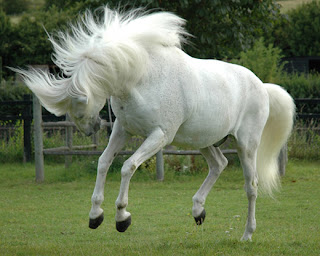For me the answer is that a painting is not a photograph and their superficial similarities are deceptive. Yes, both the painter and the photographer must decide on the composition of their image and make choices about lighting, etc., but there the similarity ends. What may be a great photo will often be an abject failure as a painting. This is not to say that as a painter one will not recognize potential paintings in photographs, because one does. It is just that a photograph can only ever be a starting point for a painting and never the final piece.
An interesting photo but not something that would make a good painting
A painting of the same horse
Much of my work focuses on horses in motion painted in great detail. Horses are a very complex subject with a difficult anatomy. Yet we all seem to have an almost instinctive understanding of how they should look and when an image is "not quite right". To paint a horse in motion requires the use of photography to truly understand their movements. Before the cinematography of Muybridge in the late 19th century, we had no real idea of how the legs of a horse moved at the faster gaits, and even the best painters of horses would paint them looking like rocking horses if they wanted to show them galloping. Yes, photographs are a huge bonus if you're trying to get it right, but they can also lie. They can flatten and distort causing muscle definition and even bones to seemingly disappear and they can foreshorten so that a head can appear to be growing straight out of a shoulder.
I take thousands of photos of horses in motion, yet I never paint any of them. I use my snapshots, together with my understanding of the horse, as a jumping of point for my work. I may use a particular image as the basis for my composition but there will be numerous other factors, including my memories, that play into the piece as I try to bring the horse to life on the canvas. It is why I have learned to insist that I must see and photograph my subject myself, because a painting is not a photograph and can never be.









